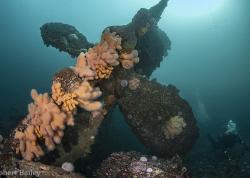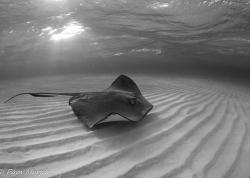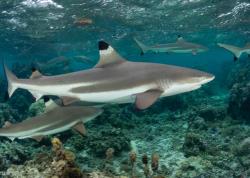Underwater Photography On A Non-Diving Vacation
Underwater Photography On A Non-Diving Vacation
Don't leave your housing at home, take it with you and get some great shots on your next non-dive vacation!
By Brent Durand
It's summertime here in the northern hemisphere, and that means many of us are planning summer vacations with friends and families. If you're like me, you're an avid diver and photographer who is going on a trip where there will be no scuba diving.
Normally it would be easy to leave your housing at home if scuba diving isn’t on the agenda, but as long as your destination has water attractions (ocean, pool, lake, river) you’ll have the opportunity to bring home some great images. While it’s easiest for compact and mirrorless shooters to throw a housing into their bag, dSLR shooters should also make the effort if space is available.

Canon s90, ISO 80, f/5.6, 1/60th. Even without scuba tanks there are great underwater images to be created.
Spending time in the water presents a great opportunity to capture friends and family snorkeling or splashing around in the shallows. Maybe your daughter made it all the way out to the swim platform or your friend thinks he’s too cool for school with sunglasses in the pool. In addition to candid shots, you’d be surprised how quickly your water buddies will volunteer to model in a scene for you – it lets them get involved, lets them see how you get your underwater shots and allows them to share a moment with you. And if you want to post the shots on Facebook you can be sure that the effort will be appreciated. The image might even turn into someone's profile photo! Different techniques will be required depending on whether the water is warm or cold, has bad vis or is crystal clear, but that’s part of the fun.

Canon s90, ISO 160, f/4.5, 1/250. Everyone likes posing for photos when they’re having fun!
Aside from the fun of capturing images, a major reason to bring along your housing is to grow your photography skills. We learn the most by pushing ourselves into new situations with our photography, so you’ll be challenging yourself in several technical areas. First off, you’ll be shooting exclusively with ambient light. As long as you’re in shallow waters you can get some excellent results, with images full of color and good contrast. You don’t want to shoot any deeper than 15 or 20ft with ambient light, so more of your breath on each dive can be spent finding an image instead of swimming up or down. When shooting with ambient light you’ll need to pay attention to the angle of the sun and the shadows it creates, usually shooting with the sun behind you. On the other hand, to create a silhouette you need to shoot into the sun, preferably with a higher aperture to create sun rays, and faster shutter to freeze those rays in the water. Reflections are also a great way to challenge your photo skills and bring a whole new element to your portfolio.

Canon s90, ISO 160, f/8, 1/1600. Shooting exclusively with ambient light can change the way you “see” potential images and lead to some interesting results.
Composition is something you’ll need to consider when shooting without strobes. The photos of people that stand out are the ones that bring the viewer a new perspective and puts them in the middle of the action. A great example is over-under images, which bring together the surreal underwater world with the topside. One trick I’ve learned for shooting above water, from the water is to lick my lens port – this creates a film that sheds water so you don’t end up with droplets on the glass.

Canon s90, ISO 100, f/7.1, 1/160. Composing scenes in shallow water with ambient light is challenging but rewarding.
As with scuba diving, I always try to have my camera ready to shoot since you never know when you’ll have the opportunity to catch that elusive perfect shot. Just a few weeks ago in Catalina I dove to the sand while snorkeling and found myself in the middle of a group of at least six bat rays. Both they and I were somewhat startled, and by the time I had my camera ready it was too late. Lesson learned, yet again…
The last thing to think about is how photos motivate people to become a certified scuba diver. So take advantage of the small size of your compact or mirrorless housing and who knows… snap a few shots and you might end up with a new scuba dive buddy for your next trip.

Canon s90, ISO 100, f/5.6, 1/125. Small housings are worth bringing along every time you’re in the water – you never know what you’ll see.
About The Author
Brent Durand is an avid California beach diver and ocean-inspired photographer. You can see more of his work at www.brentdimagery.com or follow his photography at www.facebook.com/brentdimagery.com.
Further Reading
Support the Underwater Photography Guide
Please support the Underwater Photography Guide by purchasing your underwater photography gear through our sister site, Bluewater Photo and Video. Click, or call them at (310) 633-5052 for expert advice!
RECOMMENDED ARTICLES
SUPPORT THE UNDERWATER PHOTOGRAPHY GUIDE:
The Best Service & Prices on u/w Photo Gear
 Visit Bluewater Photo & Video for all your underwater photography and video gear. Click, or call the team at (310) 633-5052 for expert advice!
Visit Bluewater Photo & Video for all your underwater photography and video gear. Click, or call the team at (310) 633-5052 for expert advice!
The Best Pricing, Service & Expert Advice to Book your Dive Trips
 Bluewater Travel is your full-service scuba travel agency. Let our expert advisers plan and book your next dive vacation. Run by divers, for divers.
Bluewater Travel is your full-service scuba travel agency. Let our expert advisers plan and book your next dive vacation. Run by divers, for divers.
































